9 Low-Maintenance Landscaping Ideas for Austin, TX
BY NICKI DESTASI | APRIL 3RD, 2023 | AUSTIN, LAWN CARE, TEXASWith so much to see and do in Austin, like Sixth Street or Lady Bird Lake, who wants to spend time maintaining their yard? But the unrelenting summer heat and low rainfall mean your lawn needs help. Consider these 9 low-maintenance landscaping ideas for Austin to help transform your struggling landscape into a backyard paradise while freeing up your time to enjoy the city.
In this article, we’ll cover:
9 Low-Maintenance Landscaping Ideas for Austin
One of the best parts of being a homeowner is enjoying your backyard. Living in Austin means you get to enjoy your yard nearly every day. But most people enjoy barbecuing brisket, not mowing their lawn. Here are 9 great low-maintenance landscaping ideas that look stunning and improve your yard’s health while saving you time and money.
1. Xeriscape Your Yard
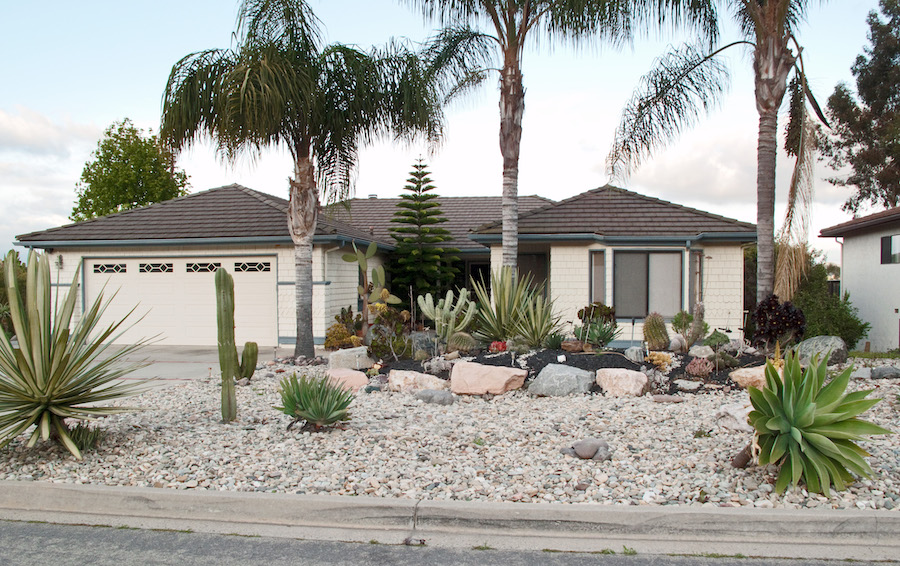
Photo Credit: Downtowngal / Wikimedia Commons / CC BY-SA 3.0
Living in Austin, you’ve likely heard of xeriscaping. If you haven’t, it’s creating a landscape that requires little or no watering. This practice is common in drought-stricken areas of the U.S., particularly the South and Southwest parts of the country.
Xeriscaping is growing in popularity because it reduces water use by 50%-75% and saves on maintenance since there is little to no need for mowing and fertilizing.
Most xeriscapes include a combination of the following:
- Drought-tolerant and drought-resistant native plants
- Mulch
- Sand
- Soil
- Rocks
- Hardscape features, like footpaths, pavers, patios, and fire pits
Converting your landscape into a xeriscape is a big project. It may be easier to start small by replacing one flower bed with succulents or a decorative rock garden and build from there. Eventually, you’ll have the xeriscape of your dreams.
Advantages of xeriscaping:
- Saves time on watering and mowing
- Reduces your water bill
- Conserves precious water resources
Estimated cost: The cost depends on how you plan to xeriscape your landscape. Professional installation averages about $5-$20 per square foot, or $17,000 for a large project, including materials and labor. You can reduce costs by making it a DIY project, but it can be backbreaking work.
2. Add a Rock Garden
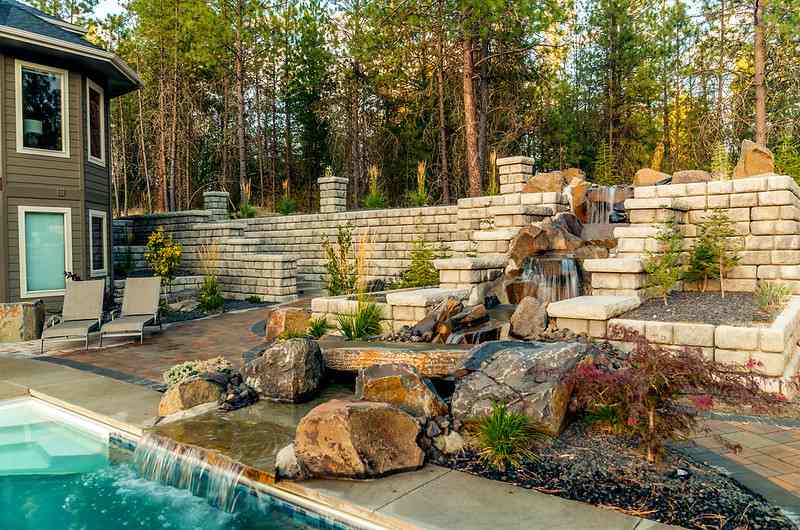
Photo Credit: Redi-Rock International / Flickr / CC BY 2.0
Sometimes called a rockery or aspen garden, a rock garden is designed to showcase rocks and boulders. With highly customizable designs, they often include drought-resistant plants, water features, and decorations like sculptures and pavers. They require very little maintenance and are perfect for Austin’s scorching summers.
Rocks that are popular in rock gardens include:
- Beach pebbles
- Mossy rocks
- Petrified wood
- Granite boulders
- Pea gravel
- Stone mosaics
- Lava rocks
- Flagstone
Common rock garden plants include:
- Flowering perennials
- Shrubs
- Succulents
- Trees
Advantages of a rock garden:
- No mowing
- Minimal weeding and watering (depending on plants)
- Provides a relaxing environment
- Unique
- Increases home value
Estimated cost: The price depends on the types of rocks and plants you choose. On average, rock gardens cost about $600-$700 to install. You can cut costs by asking farmers or construction sites for their unwanted rocks.
3. Add Native Plants
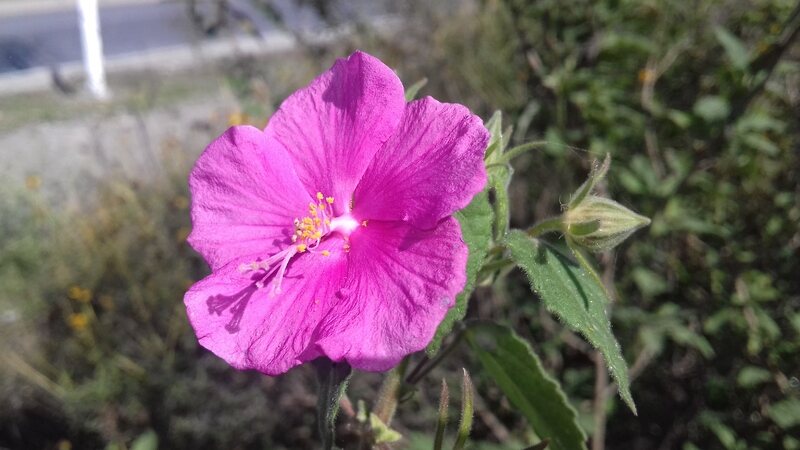
Photo Credit: PxHere
Native plants are the indigenous water and ground plant species that have evolved and occur naturally in a particular region, ecosystem, and habitat. Therefore, plants native to Austin are naturally low-maintenance. They’re less prone to pests and disease, having built natural defenses. Made for the environment, they’re drought-resistant, heat-resistant, and easy to grow.
Here are a few beautiful Austin native plants perfect for your landscape:
- Desert willow (Chilopsis linearis)
- Rock rose (Pavonia Lasiopetala)
- Winecup flower (Callirhoe Involucrata)
- Blue mistflower (Conoclinium Coelestinum)
- Hill Country penstemon (Penstemon Triflorus)
When choosing native plants, remember to choose Austin native and not Texas native. Texas is the second-largest state in the country and has seven different regions. Plants native to El Paso, Houston, and Lubbock won’t thrive as well as plants native to our area.
Advantages of native plants:
- Grow and thrive naturally in Austin’s climate
- Use less water than non-natives
- Require less fertilizer than non-natives
- Rarely need pesticides
- Provide shelter, nectar, and food for local wildlife, such as birds and pollinators
- Help to preserve local natural ecosystems
Estimated cost: How much you spend on each plant depends on the exact type and the size, but ballpark prices are $600-$3,000 for a new flower bed, $25-$50 per new shrub, or $150-$3,000 per new tree.
4. Install Hardscapes
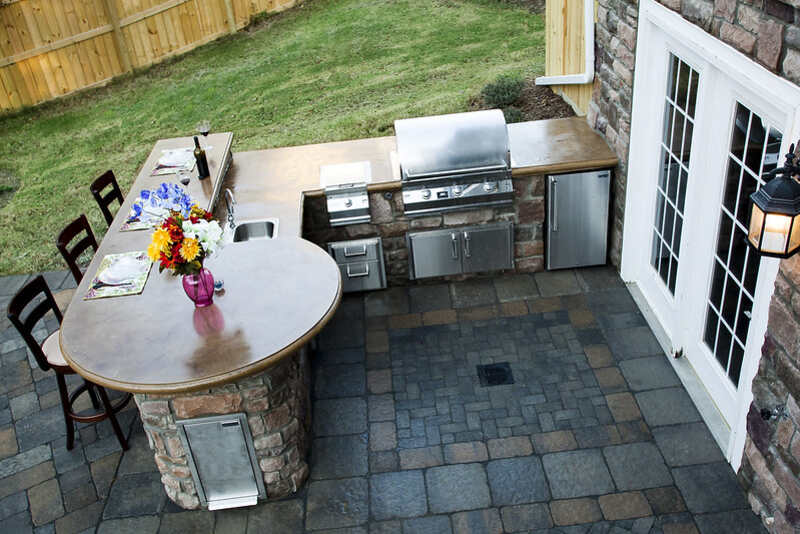
Photo Credit: Interlocking Concrete Pavement Institute / Flickr / CC BY 2.0
Less vegetation means less time maintaining it, so think about installing hardscapes. Hardscapes are any non-living feature in your yard. They’re functional, aesthetically pleasing, and low maintenance.
Here are a few common hardscapes to consider:
- Outdoor kitchens
- Pools
- Stone or gravel walkways
- Fire pits
- Pergolas, gazebos, and pavilions
- Patios
- Decks
Other than the occasional cleaning, hardscapes don’t need maintenance. That means no watering, mowing, pruning, or fertilizing, saving you time and money. Some hardscapes can be pricey, but you’d also be increasing your home’s value and curb appeal.
Advantages of hardscapes:
- Only needs occasional cleaning
- Save on water, fertilizer, pesticide, and maintenance costs
- Many hardscapes increase home value
Estimated cost: Costs will vary depending on the hardscape features you choose. Expect to spend approximately $2,000-$6,000 for a new patio, $4,000-$11,000 for a new deck, $500-$3,000 for a new fire pit, or $2,000-$9,000 for a new pergola. An outdoor kitchen ranges from $5,000 to $17,000.
5. Turn Your Lawn to Clover
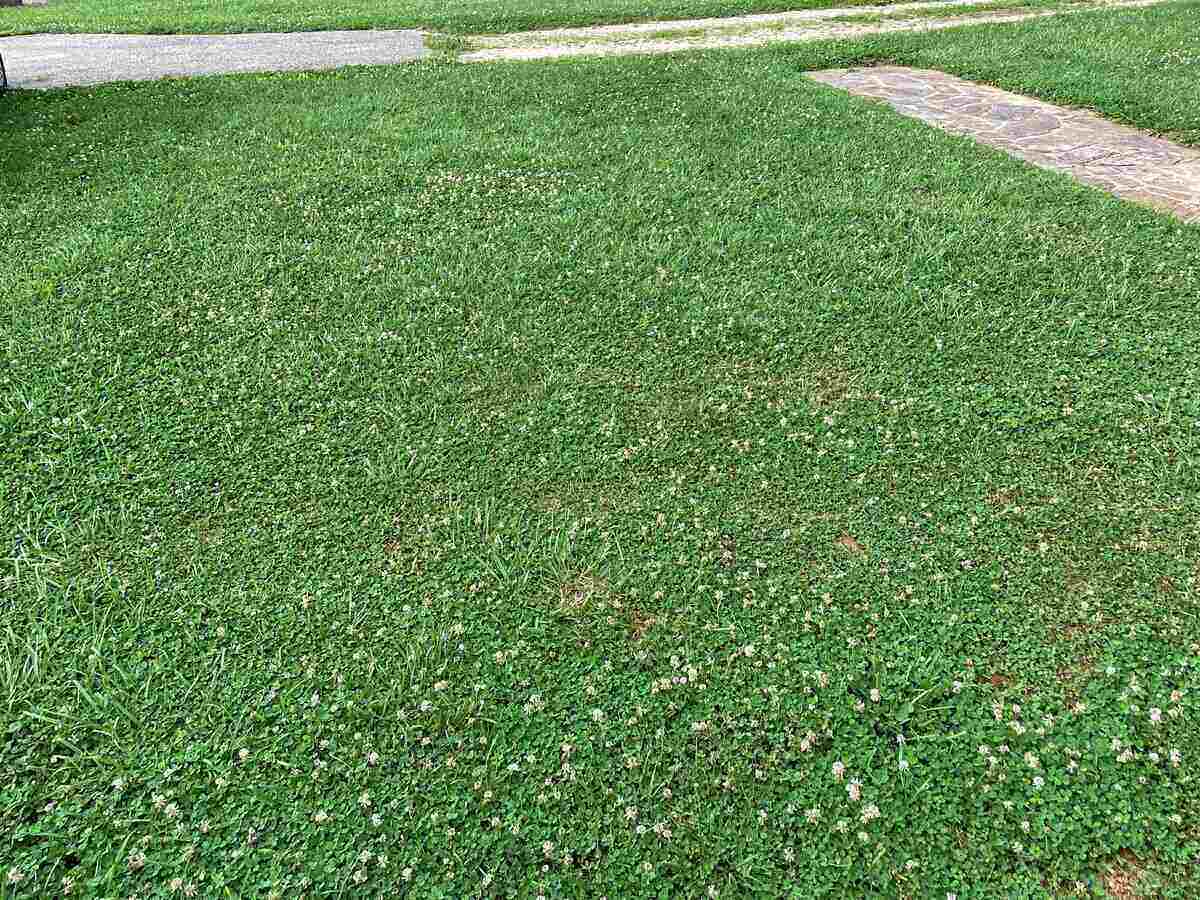
Photo Credit: Brenda Stuart/Wikilawn
For a thick, green, eco-friendly groundcover, try a clover lawn. Known for their shamrock-shaped leaves, clover lawns are heat-tolerant, drought-tolerant, and weed-resistant. They don’t need frequent mowing, don’t need aeration, reduce insects in your yard, and attract pollinators.
But isn’t clover a weed? No, not really. Before the rise of herbicides in the 1950s, clover grew on every lawn. Because herbicides kill nearly everything but grass, chemical companies pushed the “clovers are weeds” story. Clover was labeled undesirable.
But in fact, clover and turfgrass are companion plants, helping each other thrive. They fix nitrogen into the soil, acting as a natural fertilizer for grass and surrounding plants. Now clover is considered a living mulch and is quickly gaining back popularity.
Advantages of a clover lawn:
- Fertilizes itself by drawing in nitrogen from the air
- Reduces weeds. Clover is broad-leaved and crowds out other broad-leaved plants like dandelions, violets, etc.
- Pollinator-friendly
- Needs minimal mowing
- Needs less water than most turfgrasses
- Doesn’t need aeration
If you’re interested in companion planting your clover with turfgrass, choose a grass type that is best for Austin lawns.
Estimated cost: Clover seeds are much cheaper than grass seeds — about $1 per 1,000 square feet.
6. Use Automatic Irrigation for Your Lawn
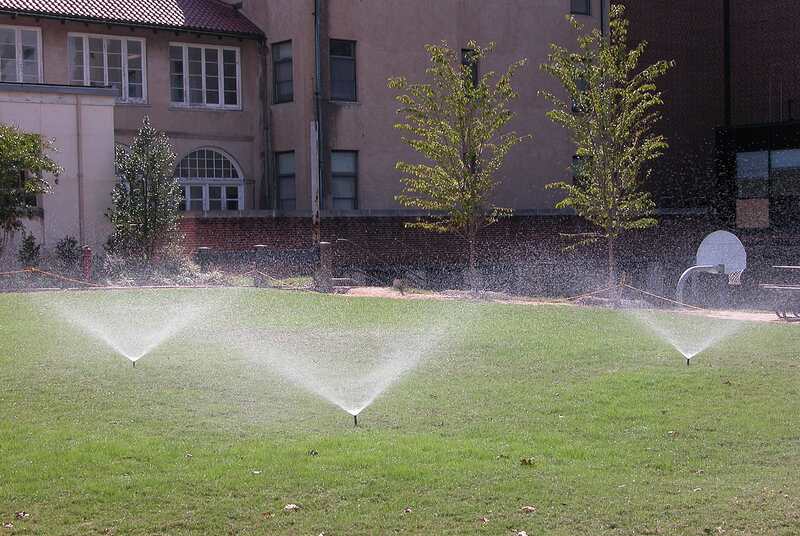
Photo Credit: Ildar Sagdejev (Specious) / Wikimedia Commons / CC BY-SA 3.0
The scorching hot sun and intermittent rainfall in Austin during the summers are challenging if you love having luscious, green turfgrass. You have to water your lawn every few days, which takes forever — unless you install an automatic irrigation system.
Automatic irrigation allows you to set a timer for a predetermined time (about 8 a.m. or 6 p.m. is best) and length of time (for Austin, about 10-15 minutes is ideal). Once your system is set, you can walk away knowing your lawn and plants are well-hydrated year-round. Also, most systems are easy to adjust when you’re expecting more or less rainfall than normal.
Advantages of automatic irrigation:
- Saves time
- Conserves water
- Saves money on water usage
Estimated cost: Depending on the size of your yard and the system you choose, automatic irrigation installation costs about $2,000 to $4,900.
7. Mulch Flower Beds
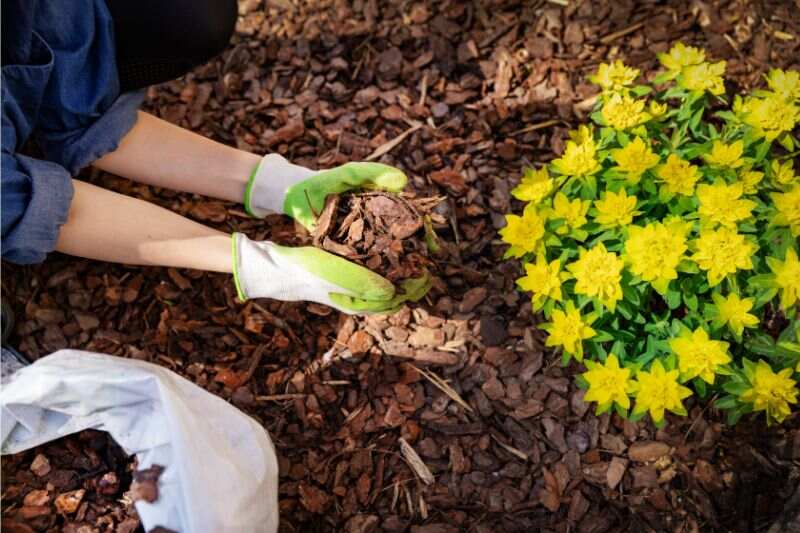
Photo Credit: ronstik / Canva Pro / License
One of the most cost-effective, low-maintenance landscape ideas is mulch. Using mulch in your flower beds retains moisture, maintains soil temperature, and suppresses weeds while making plants pop in your yard. Mulching your beds is an easy DIY project. Inorganic mulches, like rubber and gravel, cost more but last for about 10 years. Organic mulch, like wood chips, costs less but needs to be replaced yearly.
Types of organic mulch:
- Grain straw
- Fresh or old hay
- Chipped brush
- Wood chips
- Wood shavings
- Tree leaves
- Cotton gin waste
- Rice or buckwheat hulls
Types of inorganic mulch:
- Rock (lava, river, white, pink, gravel, pebbles, and river rocks)
- Plastic
- Landscape fabrics
- Shredded rubber
- Reflective metallic
Advantages of mulch:
- Reduces weeds in plant beds
- Helps retain water in the soil
- Looks beautiful and helps your plants pop
Estimated cost: Wood mulch usually costs about $3-$5 per 2-cubic-foot bag. Rubber mulch costs about $7-$10 per 0.8 cubic-foot bag. Landscape gravel ranges a lot in price depending on the type of stone, from $4-$30 per 0.5 cubic-foot bag. You also can buy in bulk to further reduce cost.
8. Create a Rain Garden
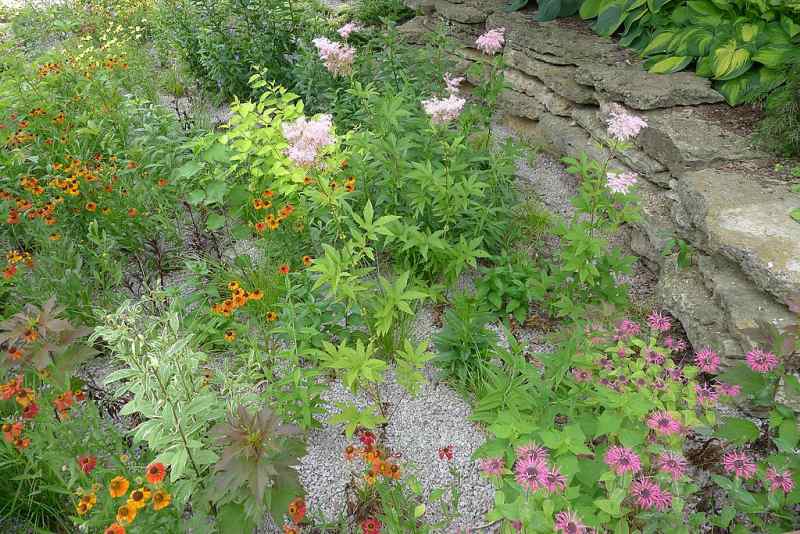
Photo Credit: James Steakley / Wikimedia Commons / CC BY-SA 4.0
If you haven’t heard of a rain garden, you’re missing out. A rain garden consists of plants (usually native) in a shallow depression dug into your yard. The idea is that runoff rainwater will pool into your rain garden and water your plants. The depression also reduces flood risk, improves drainage, and recharges groundwater, making you eligible for a rebate.
Rain gardens don’t require mowing, fertilization, herbicides, or pesticides, saving you money. The native plants naturally attract pollinators and biodiversity, which improves your lawn’s health. The plants also filter out chemicals, reducing water pollution. Plus, you’re helping to conserve water, a hugely precious resource given our population explosion.
If a rain garden sounds right for you, here’s how to get started:
- Choose the right location: You’ll want a spot that may already naturally collect water, at least 10 feet from your home, and have a slope of less than 10 percent.
- Check the soil: You need at least a foot of soil, and knowing the soil type will help you choose the best Austin-native plants.
- Plot your garden: Measure your garden’s size and exact location and plot it using paint or stakes.
- Dig: Dig out about 6 inches of soil to create the depression.
- Choose and install plants: Your best bet is to use Austin-native plants or plants that thrive in our USDA plant hardiness zone. We’re zone 8a or 8b, depending on where you live in Austin.
Advantages of rain gardens:
- Saves time and money
- Conserves water
- Helps reduce flooding and erosion
- Protects water quality
Estimated cost: Installing a rain garden yourself will cost about $1-$5 per square foot, depending on the size and the type of plants you choose. If you want to hire a professional, a rain garden will cost about $10-$20 per square foot.
9. Create a Water Garden
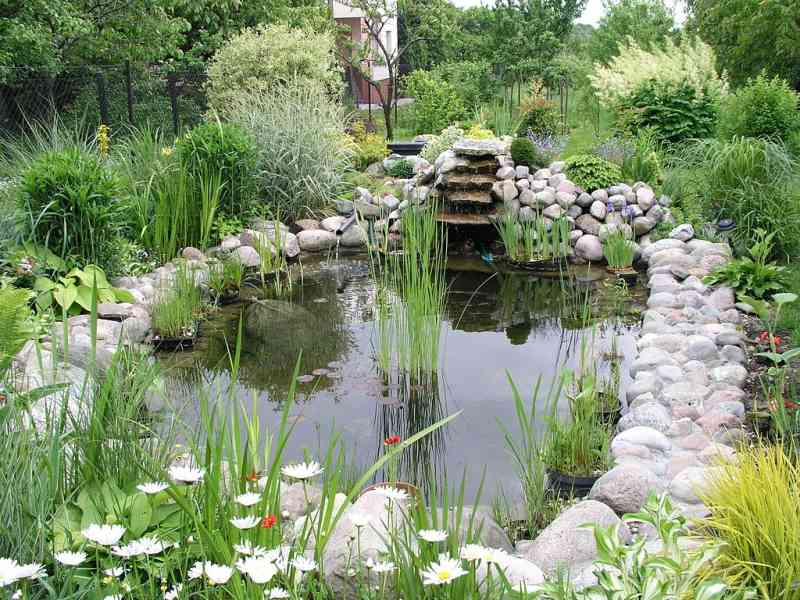
Photo Credit: Nowis / Wikimedia Commons / CC BY-SA 3.0
A water garden, sometimes called an aquatic garden, is created in a water feature. Water gardens range from patio containers to man-made ponds and come in almost any shape and size. You’ll also be providing a water source for local wildlife, like deer, rabbits, and birds, and other organisms, which improves your yard’s health.
While you can grow a vast range of plants in your water garden, you also can include fish, like goldfish, koi fish, fathead minnows, and guppies. Dell Children’s Medical Center has a gorgeous water garden featuring koi fish. Want more? Add lighting, seating, and additional water features like a waterfall or fountain.
If you want to create a spot in your yard that provides peace and tranquility, a water garden is a great idea. While you’ll need to maintain your water garden like a pool, you’ll save time and money on watering, mowing, fertilizing, and pest control for your lawn.
Here’s a list of plants you can enjoy in your water garden:
- Bog plants: Water iris, rose pogonia, ladies tresses, pitcher plants
- Floating plants: Duckweed, water lettuce, water lilies, lotuses, water hyacinth, spatterdock
- Oxygenating plants: Hornwort, eelgrass, anacharis, cabomba
- Marginal plants: Cattails, arrowhead, pickerelweed, water plantain, sweet flag
Advantages of water gardens:
- A water source for wildlife
- Provides soothing sounds reduce stress, which is good for your health
- Less mowing, fertilizer, and pesticides
- Conserves water because it replenishes with rainwater
Estimated cost: Small patio containers are relatively easy and inexpensive. However, if you want a larger one or a pond, professional installation ranges from $3,675 to $14,500.
FAQ for Low-Maintenance Landscaping Ideas for Austin
Outdoor landscape lighting is inexpensive and has many benefits:
• Aesthetics: Simple lighting is beautiful, highlights plants, and adds texture to a nighttime landscape
• Visibility: With outdoor lighting, you can enjoy outdoor activities longer
• Safety: Traverse the lawn and landscaping without tripping over everything
• Security: A well-lit landscape deters intruders by eliminating dark areas that would conceal movement
Regular lawn care protects your turf from lawn-damaging weeds, diseases, and insects. It also ensures your flowers, trees, and shrubs are healthy. A well-cared-for lawn is less susceptible to floods and erosion, too.
Long grass entices dangerous snakes, rodents, and spiders, so you need to regularly mow your lawn to keep you and your family safe. And if you’re like one in four homeowners who has an HOA, regular lawn care protects against HOA fees, too.
Native plants will be the most low-maintenance plants in Austin. They are used to little water and high heat. They also have natural defenses against insects and diseases.
Here are a few of the most low-maintenance Austin-native plants.
• Little bluestem (Schizachyrium Scoparium)
• Desert willow (Chilopsis Linearis)
• Texas sage (Leucophyllum Frutescens)
• Rockrose (Pavonia Lasiopetala)
• Flame acanthus (Anisacanthus Quadrifidus var. Wrightii)
Get Help with Your Low-Maintenance Austin Landscape
If you prefer spending your outdoor time playing sports, sunbathing, or smoking a brisket in your backyard but still want a beautiful, low-maintenance landscape, we can help. Whether you need a hardscape or lawn mowed, we have an experienced, highly-rated local Austin professional who can help with all your landscaping needs.
Main Photo Credit: Pam Penick’s Austin Front Yard / Susan Harris / Flickr / CC BY 2.0